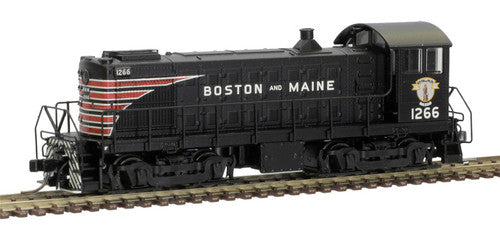The ATLAS Gold 40005025 is an outstanding N scale model train. It represents the ALCO S-4 locomotive of Boston & Maine 1271, painted in attractive black, red, and white colors. Note that the pictures might show a different road number. Introduced in 1950, the Alco S-4 was a 1000 horsepower switcher, with 636 units built for North American railroads. The main difference between S-1/S-2 and S-3/S-4 lies in the trucks: S-1/S-2 has Blunt trucks, while S-3/S-4 has AAR-style trucks. The S-2 and S-4 were very versatile, serving on mainline railroads, shortlines, and industrial tracks. This model has many great features. It's scaled from actual prototype measurements, with 2 cab variations (riveted or welded) and options for horizontal or vertical radiator shutters. It has fine scale handrails, and separately-applied coupler cut levers, air hoses, and piping. The directional LED lighting includes a cab rear headlight. The die-cast hood and chassis improve pulling performance, and dual-flywheels ensure maximum performance at all speeds. It comes factory-equipped with AccuMate® knuckle couplers and has exceptional painting and printing. The Atlas Master® Gold version features an ESU LokSound Decoder. For DCC operation, it supports all DCC-programming modes, has flexible mapping of function keys F0 to F28, offers 4 DCC function outputs, and follows all NMRA DCC standards. The sound functionality (only for GOLD LOCOMOTIVES) offers over 20 sound effects, 16 user-selectable horns, 2 user-selectable bells, and 2 user-selectable synchronized brake squeals. It also has manual and automatic notching modes that you can change 'on the fly' for a realistic experience.

Using this ATLAS Gold 40005025 N scale model train is easy. First, make sure you have a suitable DCC system set up according to the model's DCC operation features. Connect the train to the system and power it on. You can use the function keys to control different functions like the LED lighting, sound effects, and more. When it comes to sound, you can select different horns, bells, and enjoy the various engine and brake sounds. For the best performance, keep the train on a clean and smooth track. Avoid exposing it to extreme temperatures or humidity. To maintain it, regularly clean the wheels and electrical contacts with a soft, dry cloth. You can also check the couplers and other small parts for any signs of wear or damage. If you need to store the train, put it in a protective case to prevent scratches and other physical damage.









